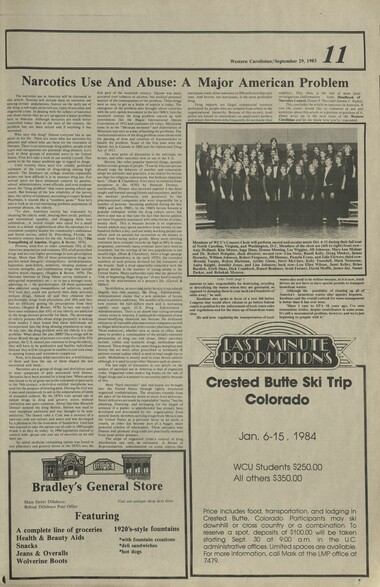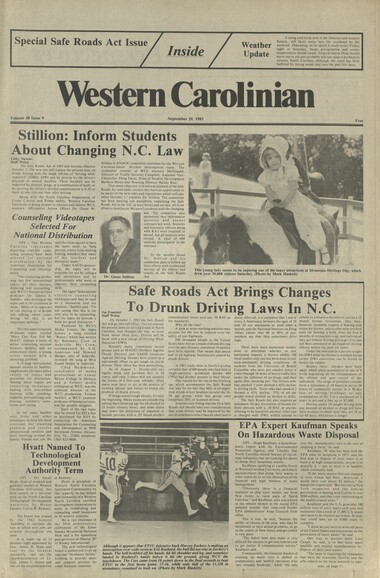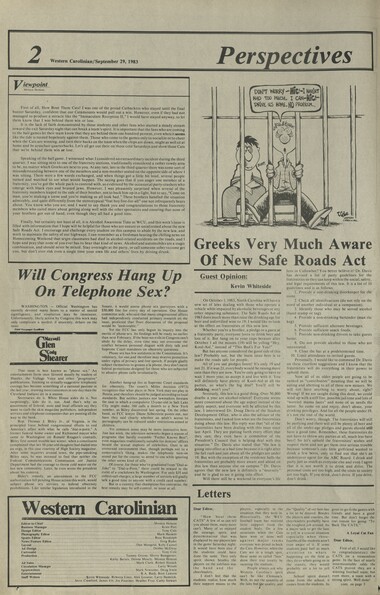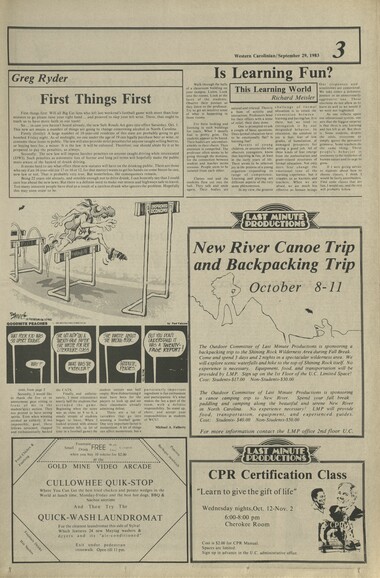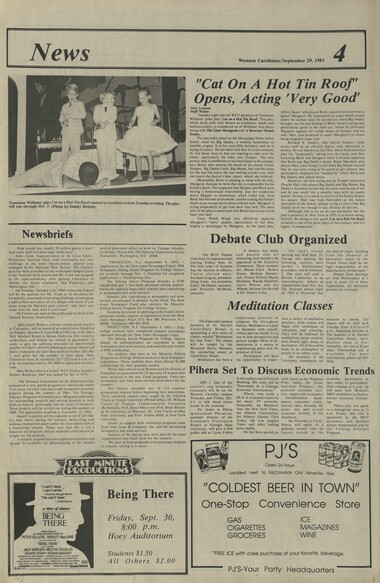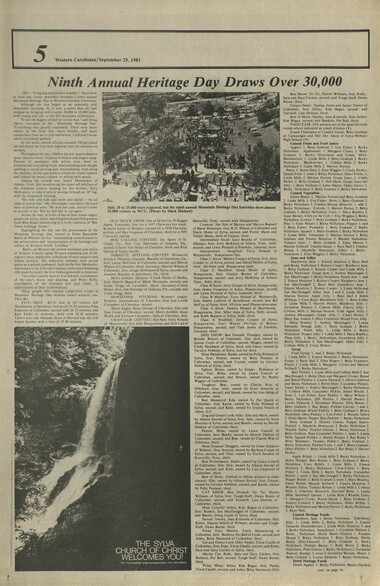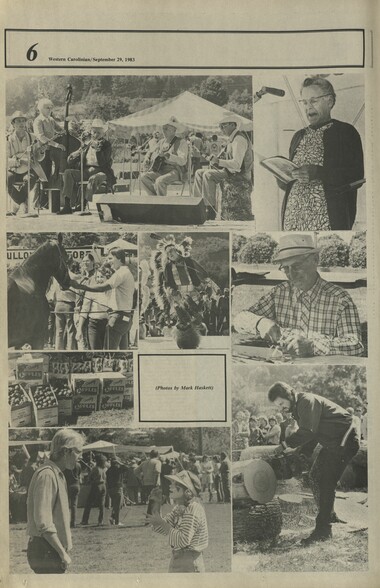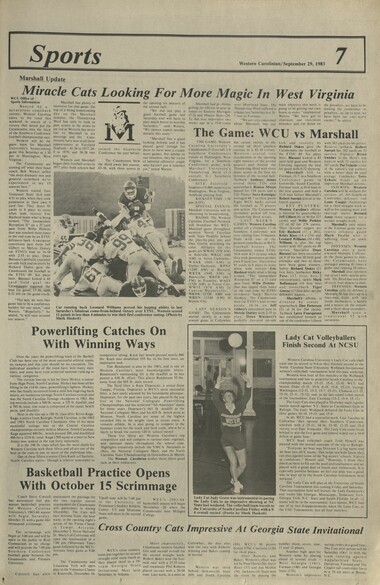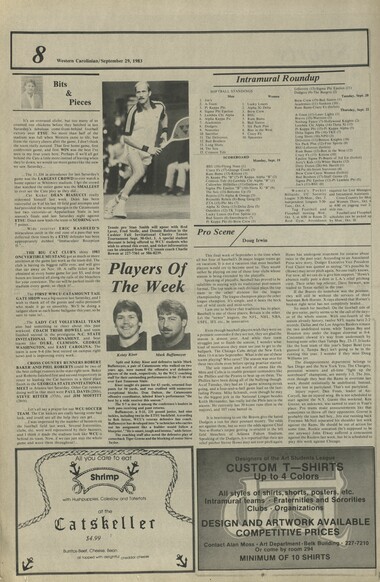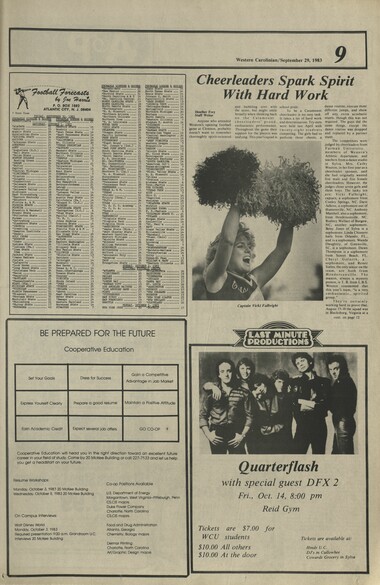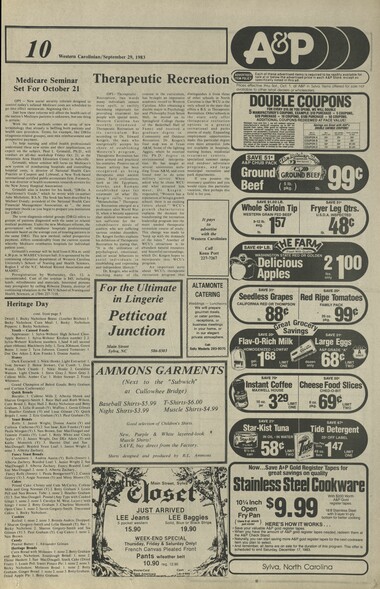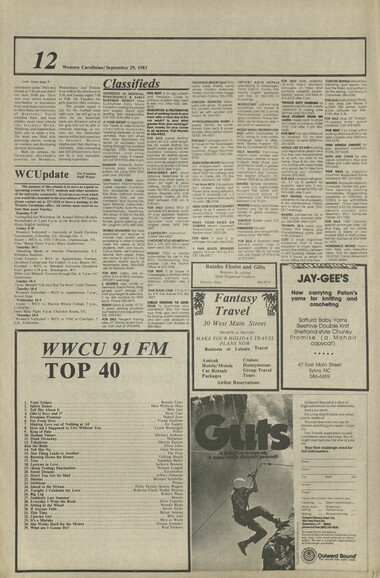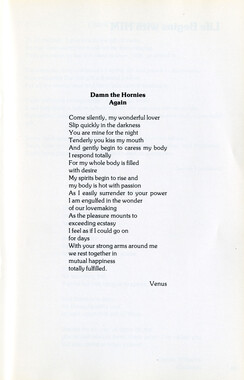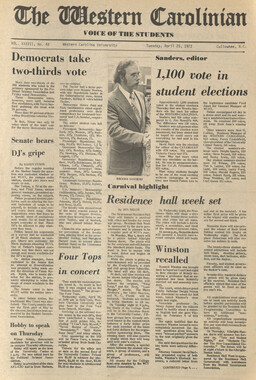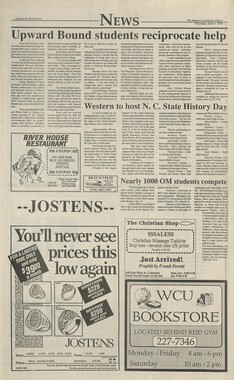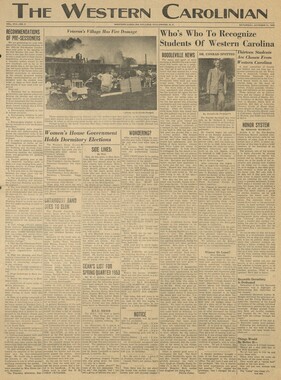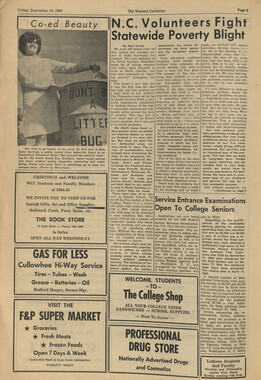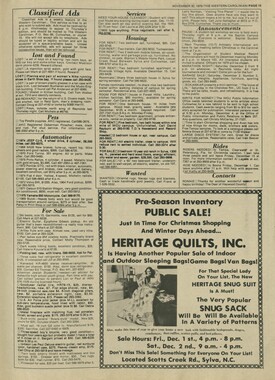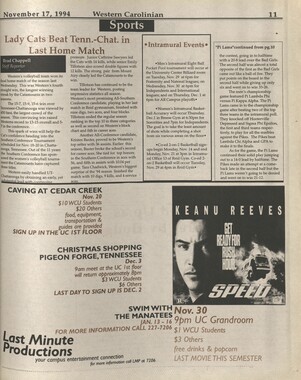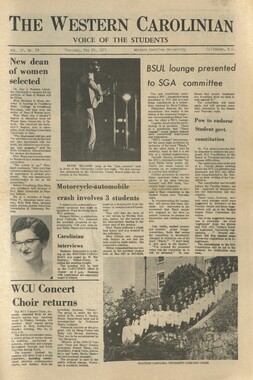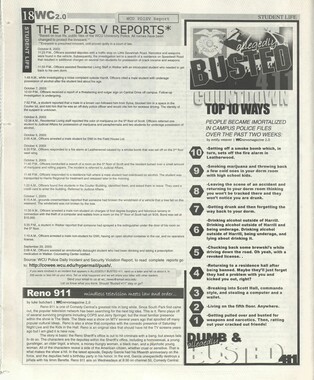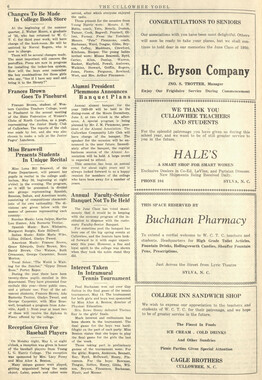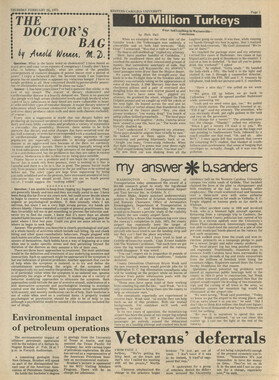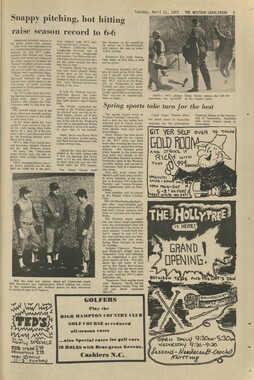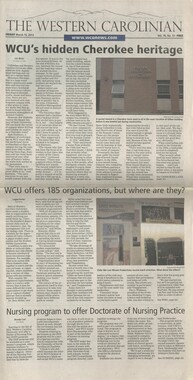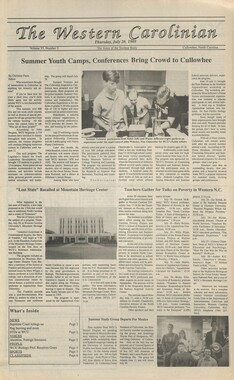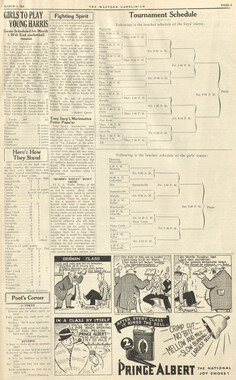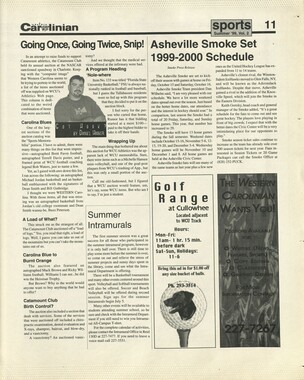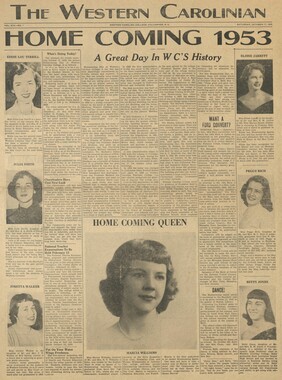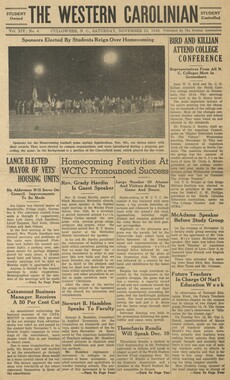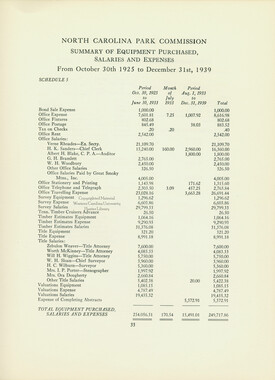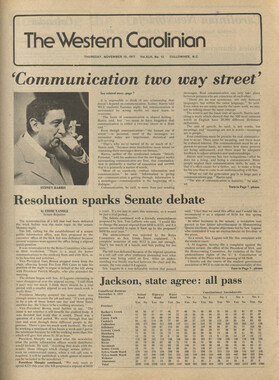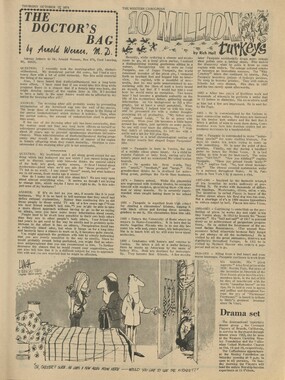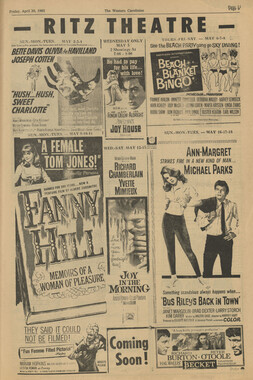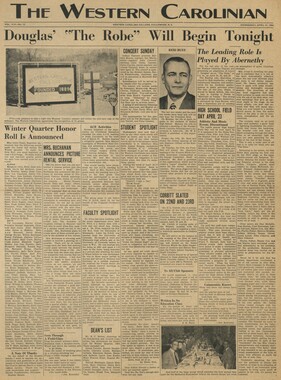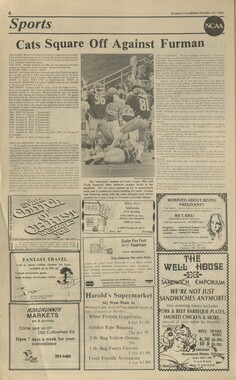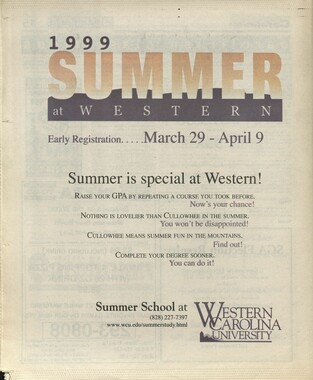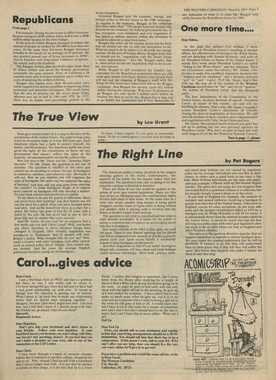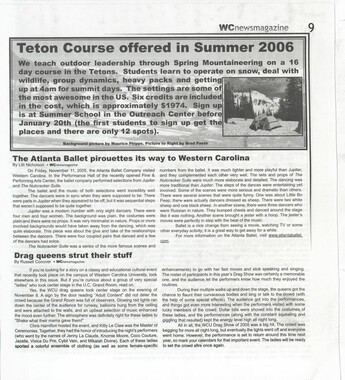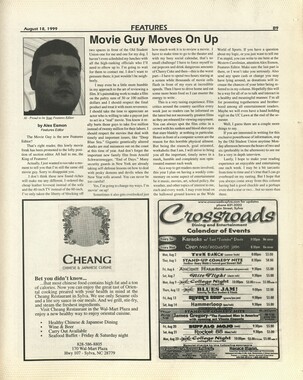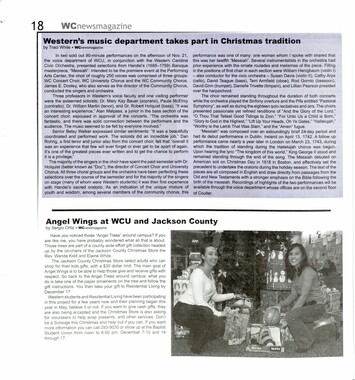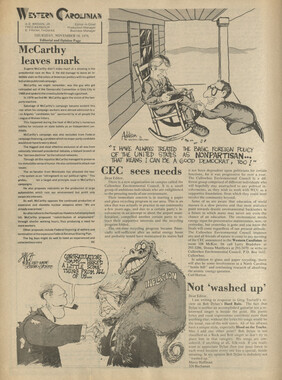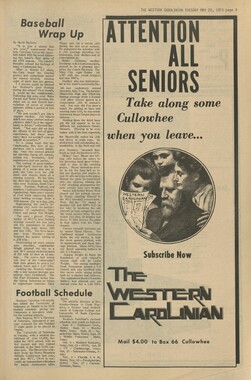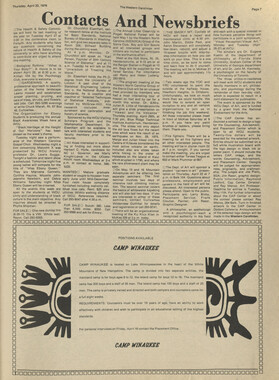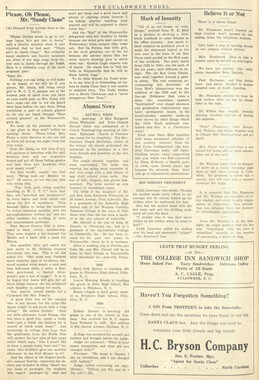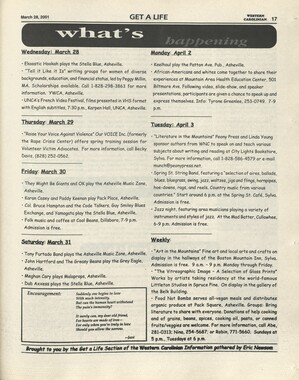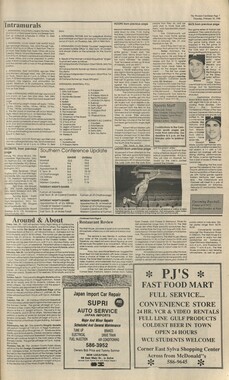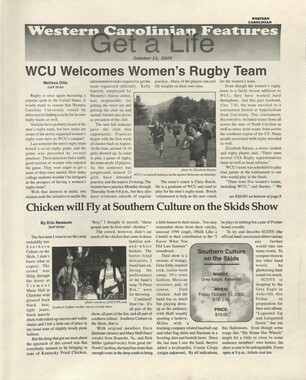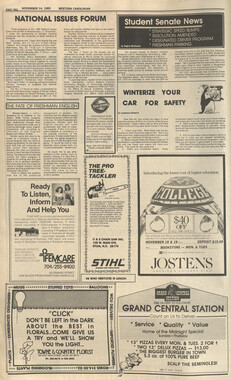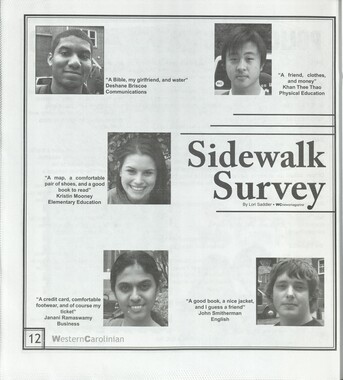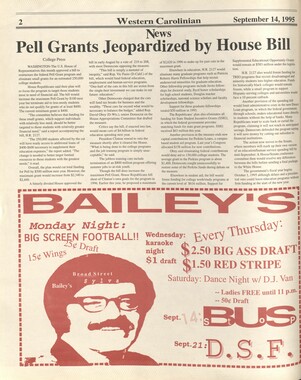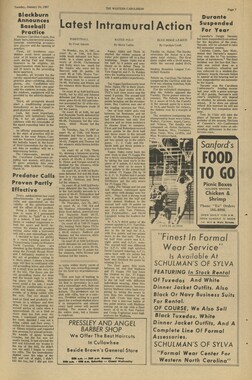Western Carolina University (20)
View all
- Canton Champion Fibre Company (2308)
- Cherokee Traditions (291)
- Civil War in Southern Appalachia (165)
- Craft Revival (1942)
- Great Smoky Mountains - A Park for America (2946)
- Highlights from Western Carolina University (430)
- Horace Kephart (941)
- Journeys Through Jackson (159)
- LGBTQIA+ Archive of Jackson County (85)
- Oral Histories of Western North Carolina (314)
- Picturing Appalachia (6873)
- Stories of Mountain Folk (413)
- Travel Western North Carolina (160)
- Western Carolina University Fine Art Museum Vitreograph Collection (129)
- Western Carolina University Herbarium (92)
- Western Carolina University: Making Memories (738)
- Western Carolina University Publications (2488)
- Western Carolina University Restricted Electronic Theses and Dissertations (146)
- Western North Carolina Regional Maps (71)
- World War II in Southern Appalachia (131)
University of North Carolina Asheville (6)
View all
- Western Carolina College (199)
- Western Carolina Teachers College (239)
- Western Carolina University (1973)
- Allanstand Cottage Industries (0)
- Appalachian National Park Association (0)
- Bennett, Kelly, 1890-1974 (0)
- Berry, Walter (0)
- Brasstown Carvers (0)
- Cain, Doreyl Ammons (0)
- Carver, George Washington, 1864?-1943 (0)
- Cathey, Joseph, 1803-1874 (0)
- Champion Fibre Company (0)
- Champion Paper and Fibre Company (0)
- Cherokee Indian Fair Association (0)
- Cherokee Language Program (0)
- Crittenden, Lorraine (0)
- Crowe, Amanda (0)
- Edmonston, Thomas Benton, 1842-1907 (0)
- Ensley, A. L. (Abraham Lincoln), 1865-1948 (0)
- Fromer, Irving Rhodes, 1913-1994 (0)
- George Butz (BFS 1907) (0)
- Goodrich, Frances Louisa (0)
- Grant, George Alexander, 1891-1964 (0)
- Heard, Marian Gladys (0)
- Kephart, Calvin, 1883-1969 (0)
- Kephart, Horace, 1862-1931 (0)
- Kephart, Laura, 1862-1954 (0)
- Laney, Gideon Thomas, 1889-1976 (0)
- Masa, George, 1881-1933 (0)
- McElhinney, William Julian, 1896-1953 (0)
- Niggli, Josephina, 1910-1983 (0)
- North Carolina Park Commission (0)
- Osborne, Kezia Stradley (0)
- Owens, Samuel Robert, 1918-1995 (0)
- Penland Weavers and Potters (0)
- Rhodes, Judy (0)
- Roberts, Vivienne (0)
- Roth, Albert, 1890-1974 (0)
- Schenck, Carl Alwin, 1868-1955 (0)
- Sherrill's Photography Studio (0)
- Smith, Edward Clark (0)
- Southern Highland Handicraft Guild (0)
- Southern Highlanders, Inc. (0)
- Stalcup, Jesse Bryson (0)
- Stearns, I. K. (0)
- Thompson, James Edward, 1880-1976 (0)
- United States. Indian Arts and Crafts Board (0)
- USFS (0)
- Vance, Zebulon Baird, 1830-1894 (0)
- Weaver, Zebulon, 1872-1948 (0)
- Western Carolina University. Mountain Heritage Center (0)
- Whitman, Walt, 1819-1892 (0)
- Wilburn, Hiram Coleman, 1880-1967 (0)
- Williams, Isadora (0)
- 1920s (57)
- 1930s (69)
- 1940s (114)
- 1950s (66)
- 1960s (314)
- 1970s (599)
- 1980s (406)
- 1990s (379)
- 2000s (282)
- 2010s (175)
- 1600s (0)
- 1700s (0)
- 1800s (0)
- 1810s (0)
- 1820s (0)
- 1830s (0)
- 1840s (0)
- 1850s (0)
- 1860s (0)
- 1870s (0)
- 1880s (0)
- 1890s (0)
- 1900s (0)
- 1910s (0)
- 2020s (0)
- Jackson County (N.C.) (2463)
- Appalachian Region, Southern (0)
- Asheville (N.C.) (0)
- Avery County (N.C.) (0)
- Blount County (Tenn.) (0)
- Buncombe County (N.C.) (0)
- Cherokee County (N.C.) (0)
- Clay County (N.C.) (0)
- Graham County (N.C.) (0)
- Great Smoky Mountains National Park (N.C. and Tenn.) (0)
- Haywood County (N.C.) (0)
- Henderson County (N.C.) (0)
- Knox County (Tenn.) (0)
- Knoxville (Tenn.) (0)
- Lake Santeetlah (N.C.) (0)
- Macon County (N.C.) (0)
- Madison County (N.C.) (0)
- McDowell County (N.C.) (0)
- Mitchell County (N.C.) (0)
- Polk County (N.C.) (0)
- Qualla Boundary (0)
- Rutherford County (N.C.) (0)
- Swain County (N.C.) (0)
- Transylvania County (N.C.) (0)
- Watauga County (N.C.) (0)
- Waynesville (N.C.) (0)
- Yancey County (N.C.) (0)
- Newsletters (510)
- Publications (documents) (1978)
- Aerial Photographs (0)
- Aerial Views (0)
- Albums (books) (0)
- Articles (0)
- Artifacts (object Genre) (0)
- Bibliographies (0)
- Biography (general Genre) (0)
- Cards (information Artifacts) (0)
- Clippings (information Artifacts) (0)
- Copybooks (instructional Materials) (0)
- Crafts (art Genres) (0)
- Depictions (visual Works) (0)
- Design Drawings (0)
- Drawings (visual Works) (0)
- Envelopes (0)
- Exhibitions (events) (0)
- Facsimiles (reproductions) (0)
- Fiction (general Genre) (0)
- Financial Records (0)
- Fliers (printed Matter) (0)
- Glass Plate Negatives (0)
- Guidebooks (0)
- Internegatives (0)
- Interviews (0)
- Land Surveys (0)
- Letters (correspondence) (0)
- Manuscripts (documents) (0)
- Maps (documents) (0)
- Memorandums (0)
- Minutes (administrative Records) (0)
- Negatives (photographs) (0)
- Newspapers (0)
- Notebooks (0)
- Occupation Currency (0)
- Paintings (visual Works) (0)
- Pen And Ink Drawings (0)
- Periodicals (0)
- Personal Narratives (0)
- Photographs (0)
- Plans (maps) (0)
- Poetry (0)
- Portraits (0)
- Postcards (0)
- Programs (documents) (0)
- Questionnaires (0)
- Relief Prints (0)
- Sayings (literary Genre) (0)
- Scrapbooks (0)
- Sheet Music (0)
- Slides (photographs) (0)
- Songs (musical Compositions) (0)
- Sound Recordings (0)
- Specimens (0)
- Speeches (documents) (0)
- Text Messages (0)
- Tintypes (photographs) (0)
- Transcripts (0)
- Video Recordings (physical Artifacts) (0)
- The Reporter, Western Carolina University (510)
- WCU Students Newspapers Collection (1920)
- A.L. Ensley Collection (0)
- Appalachian Industrial School Records (0)
- Appalachian National Park Association Records (0)
- Axley-Meroney Collection (0)
- Bayard Wootten Photograph Collection (0)
- Bethel Rural Community Organization Collection (0)
- Blumer Collection (0)
- C.W. Slagle Collection (0)
- Canton Area Historical Museum (0)
- Carlos C. Campbell Collection (0)
- Cataloochee History Project (0)
- Cherokee Studies Collection (0)
- Daisy Dame Photograph Album (0)
- Daniel Boone VI Collection (0)
- Doris Ulmann Photograph Collection (0)
- Elizabeth H. Lasley Collection (0)
- Elizabeth Woolworth Szold Fleharty Collection (0)
- Frank Fry Collection (0)
- George Masa Collection (0)
- Gideon Laney Collection (0)
- Hazel Scarborough Collection (0)
- Hiram C. Wilburn Papers (0)
- Historic Photographs Collection (0)
- Horace Kephart Collection (0)
- Humbard Collection (0)
- Hunter and Weaver Families Collection (0)
- I. D. Blumenthal Collection (0)
- Isadora Williams Collection (0)
- Jesse Bryson Stalcup Collection (0)
- Jim Thompson Collection (0)
- John B. Battle Collection (0)
- John C. Campbell Folk School Records (0)
- John Parris Collection (0)
- Judaculla Rock project (0)
- Kelly Bennett Collection (0)
- Love Family Papers (0)
- Major Wiley Parris Civil War Letters (0)
- Map Collection (0)
- McFee-Misemer Civil War Letters (0)
- Mountain Heritage Center Collection (0)
- Norburn - Robertson - Thomson Families Collection (0)
- Pauline Hood Collection (0)
- Pre-Guild Collection (0)
- Qualla Arts and Crafts Mutual Collection (0)
- R.A. Romanes Collection (0)
- Rosser H. Taylor Collection (0)
- Samuel Robert Owens Collection (0)
- Sara Madison Collection (0)
- Sherrill Studio Photo Collection (0)
- Smoky Mountains Hiking Club Collection (0)
- Stories of Mountain Folk - Radio Programs (0)
- Venoy and Elizabeth Reed Collection (0)
- WCU Gender and Sexuality Oral History Project (0)
- WCU Mountain Heritage Center Oral Histories (0)
- WCU Oral History Collection - Mountain People, Mountain Lives (0)
- Western North Carolina Tomorrow Black Oral History Project (0)
- William Williams Stringfield Collection (0)
- Zebulon Weaver Collection (0)
- College student newspapers and periodicals (1948)
- African Americans (0)
- Appalachian Trail (0)
- Artisans (0)
- Cherokee art (0)
- Cherokee artists -- North Carolina (0)
- Cherokee language (0)
- Cherokee pottery (0)
- Cherokee women (0)
- Church buildings (0)
- Civilian Conservation Corps (U.S.) (0)
- Dams (0)
- Dance (0)
- Education (0)
- Floods (0)
- Folk music (0)
- Forced removal, 1813-1903 (0)
- Forest conservation (0)
- Forests and forestry (0)
- Gender nonconformity (0)
- Great Smoky Mountains National Park (N.C. and Tenn.) (0)
- Hunting (0)
- Landscape photography (0)
- Logging (0)
- Maps (0)
- Mines and mineral resources (0)
- North Carolina -- Maps (0)
- Paper industry (0)
- Postcards (0)
- Pottery (0)
- Railroad trains (0)
- Rural electrification -- North Carolina, Western (0)
- School integration -- Southern States (0)
- Segregation -- North Carolina, Western (0)
- Slavery (0)
- Sports (0)
- Storytelling (0)
- Waterfalls -- Great Smoky Mountains (N.C. and Tenn.) (0)
- Weaving -- Appalachian Region, Southern (0)
- Wood-carving -- Appalachian Region, Southern (0)
- World War, 1939-1945 (0)
- Text (2488)
- MovingImage (0)
- Sound (0)
- StillImage (0)
Western Carolinian Volume 48 Number 09
Item
Item’s are ‘child’ level descriptions to ‘parent’ objects, (e.g. one page of a whole book).
-
-
Western Carolinian/ September 29, 1983 // Narcotics Use And Abuse: A Major American Problem The narcotics use in America will be discussed in this article. Sources will include data on narcotics use among certain populations, history on the early use of the drug, a sub-topic on heroin use, types of narcotics and organized crime. In dealing with the subject of narcotics one must realize that we are up against a major problem here in America. Although narcotics are much better controlled today than at the turn of the century, the problem has not been solved and if anything it has worsened. Who uses this drug? Almost everyone has at one point in his life. There are some who use narcotics for pleasure and others who use them for the treatment of illnesses. There is no stereotype drug addict; people of all types and occupations are potential drug abusers. Let's look at these groups of potential users in the United States. First let's take a look at our society's youth. This seems to be the major problem age in regard to drugs. Until recently there were few reliably published estimates of the extent of drug-taking among high schools. The literature on college students repeatedly points out how difficult it is to measure drug use. For several years we have witnessed concern by parents, school administrators, town officials, and even students about the "drug problem" that exists among school age youth. But because of the low reliability of the survey data, the variety of estimates, according to expert Samuel Pearlman, it sounds like a "numbers game." Now let's take a look at an ever-increasing problem population of potential abusers, the elderly. "To date, American society has responded by shunting the elderly aside, denying their social, political, and economical equality, and drugging them into submission....A retired couple who opted for a small home in a mixed neighborhood after the salesman for a retirement complex lauded the community's ambulance and burial service, called St. Petersburg, Florida, the twentiety century haven for the old, Vatican City,"(The Tranquilizing of America, Hughes & Brown, 1978). Persons, sixty-five or older constitute 10% of the American population and consume 25% of all prescribed drugs and an even higher percentage fo non-prescription drugs. More than 20% of these prescription drugs are psychic mood changers —tranquilizers, antidepressants, hypnotics, pain-killers, sedatives, sleeping potions of various strengths, and combination drugs that include hidden mood changers, (Hughes & Brown, 1978). The National Institute of Drug Abuse survey indicated a widespread dependency on — or to use a stronger term, addiction to — the psychotropics. Of those questioned who reported using tranquilizers nd sedatives, nearly 51% said they could not perform their daily activities without drugs. Almost all said they obtained their psychotropic drugs from physicians, and 10% said they had no difficulty getting the prescriptions from their doctors, (Hughes & Brown, 1978). In fact, one study I have seen estimates that 63% of our elderly are addicted to the drugs doctors prescribe for them. The percentage of elderly persons who abuse drugs purposely is lacking from studies I have found that these individuals are incorporated into the drug abusing population at large. At any rate, the drug problem with the elderly is a real problem. What about the year 2000? The average will be about 40 and the age of persons over sixty-five sill be 55% greater; the U.S. cannot just continue to drug the elderly, they will have to be productive and healthy individuals because they will be too great in number to just tuck away in nursing homes and retirement complexes. Now, let's discuss what narcotics are, a brief history of them and how the use of them shaped the law associated with them. Narcotics are a group of drugs and derivitives used to treat symptoms of pain associated with disease. Narcotics have been around for a long time. When opium was found to be of great use in the treatment of pain early in the 19th century, a derivitive entitled morpheme was used for the purpose of treating pain. During the civil war it was used extensively to aid in the amputations of limbs of wounded soldiers. By the 1870's wide spread sale of opium drugs in drug and grocery stores without restriction was quite common. About this time Hienrich Dresser isolated the drug Heroin. Herion was used to treat morphine addiction and was thought to be non- addictive. The famed coke a Cola was a mixture of a narcotic, cola nut extract, and water and was developed by a phrmacist for the treatment of headaches. Until law was enacted to take the opium out of coke in 1805 people drank it as they do today. In 1906 legislation started to control wide spread sale and use of narcotics as we will later see. So called medicine containing opium was found in any pharmacy and grocery stores in the 1870's into the first part of the twentieth century. Opium was more accepted over tobacco or alcohol, but medical prsonnel warned of the consequences of the problem. These drugs were as easy to get as a bottle of aspirin is today. The emergence of the problem also brought about concerns with the anti-opium movement in the late 1800's. Into the twentieth century the drug problem started up with conventions like the Hague International Opium Convention of 1912 and continues till today. Marijuana came in as the "Mexican menance" and deportation of Mexicans was seen as a way of battling the problems. The institutionalization of the drug problem came about with the passing of laws and creation of bureaucracies to handle the problem. Some of the first laws were the Opium Act in Canada in 1808 and the Opium and Drug Act of 1911. The next point of discussion is the sub-topic on herion, and other narcotics now in use in the U.S. Herion, like other popular material things, spreads within certain groups of people. "Exactly why one person should copy the behavior of another and voluntarily adopt his attitudes and practices, is no clearer for heroin use than for religious conversions, but both are empirical facts," (Hunt & Chambers). Ever since its isolation from morphene in the 1870's by Heinridt Dresser, (incidentally. Dresser also invented aspirin) it has been taught and learned among friends and associates, used by the medical profession, and produced by the pharmaceutical companies who were responsible for a number of persons becoming addicted during the late I800's and early 1900's. In the 1960's heroin became a popular substance within the drug culture scene; but there is and was at that time the fact that heroin addicts are most frequently associated with otherforms of crime, mostly theft. This is because heroin is so expensive; heroin addicts may spend anywhere from twenty to one hundred dollars a day, and not many working people can afford such an amount for recreation so the money is made from fencing stolen goods. Many users entering treatment have criminal records (as high as 98% in some programs), conversely many criminal users have been in treatment, but the overlap of the two populations is not usually high, (Hunt & Chambers). After a huge upsurge in heroin dependency in the early 1970's, the extended numbers of such persons declined for the remainder of the decade. Such a drop apparently coincided with the general decline in the number of young adults in the United States. Many authorities state that the period for "risk of beginning illegal drug use" of any kind is usually over by the mid-twenties of a person's life, (Carroll & Miller). Nevertheless, as more and purer heroin is introduced illegally into this country, the Drug Enforcement Administration claims that a new epidemic of heroin abuse is already underway. The number of heroin addicts now exceeds the half-million mark and is increasing rapidly once again. (U.S. Drug Enforcement Administration). There is no doubt that a drug-oriented ~ociety exists in America. Continued development of new mood-modifying chemicals has become the dedicated enterprise of reputable pharmaceutical companies as well as illegal laboratories and street-corner pharmacologists. These endeavors, whether seen as cause or effect, lead many to predict a continuation of the already extensive phenomena of drug use and abuse. Other narcotics include: codine and synthetic drugs, methodone and demorol. These drugs do the same thing as morphine and heroin but are more often prescribed to terminally ill patients except codine which is used to treat cough due to colds. Methadone is mostly used to treat heroin addicts although it is used to treat other illnesses such as cancer. The last topic of discussion in our article on the subject of narcotics use in America is that of organized crime. Organized crime makes big bucks on the sale of illegal drugs and is a menace to our society partly because of this. Most "hard narcotics" and marijuana are brought into the United States through tightly structured organized confederations. The structure extends from the apex ofthe hierarchy down to street level deliveries. Street deliveries are made by expendable "mules," but the planning, financing, and arranging for the length of sentence if a pusher is apprehended has already been developed and determined by the organization. Even natural family members carrying drugs from Mexico into the United States as a personal favor to an uncle, a cousin, or other kin become part of a bigger, more powerful echelon of wholesalers. These salesmen who finance and promote drug trade are practically immune from local police pressure. The scope of organized crime's control of drug distribution can only be estimated. A House of Representatives subcommittee on crime reports that I marijuana trade alone amounts to 850 million dollars per year. And heroin, not marijuana, is the most profitable drug. Drug imports are illegal commercial ventures performed by people who are isolated from others in the organizational hierarchy. Because of this secrecy, local police are forced to concentrate on small street pushers and minor distributors who frequently do not know their suppliers. I his, then, is the end of most local investigations.(Information from Handbook of Narcotics Control. Denny F. Pace and Jimmie C. Styles). This concludes the article on narcotics in America. II you the reader would like to comment or ask any questions about this article or a portion or portions of it, please write me in the next issue of the Western Carolinian and let me know how you've responded. Bradley's General Store Main Street Dillsboro Behind Dillsboro Post Office Visit our antique shop next door. Featuring A complete line of groceries Health & Beauty Aids Snacks Jeans & Overalls Wolverine Boots 1920's-style fountains ♦with fountain creations *deli sandwiches ♦hot dogs Members of WCU's Concert Choir will perform sacred and secular music Oct. 6-11 during their fall tour of North Carolina, Virginia, and Washington, D.C. Members ofthe choir are (left to right) front row- Amy Holland, Kim Moore, Inga Haas, Donna Messing, Lee Wiggins, Jill Johnson, MaryAnn Molnar and Dr. Robert Holquist, choir director; second row-Lisa Stern, Randi Kelly, Doug Meeker, James Hornsby, William Johnson, Robert Ferguson, Jill Hannay, Pamela Evans, and Julie Flowers; third row- -Brenda Turpin, Robyn Hart man, Archie Glenn, Steve MeClure, Kelly Truesdell, Mark Newsome, Anita Knight, Jennifer Jones, and Lisa Johnson; back row-Lou Ellen Wilson, Janet Kelley, Brian Burdick, Erich Haas, Dick Craddock, Russel Brahmer, Scott Farmer, David Moffit, James Jay, Susan Parker, and Rebekah Monroe. cont. from page I material to take responsibility for destroying, recycling or detoxifying the wastes where they are generated, as opposed to dumping them in your backyard hundreds of miles away," he said. Kaufman also spoke in favor of a new bill before Congress that would allow citizens to go before federal courts to petition forthe enforcement of toxic waste rules and regulations and for the clean-up of hazardous waste sites. He said laws regulating the transportation of toxic wastes also need to be written because, as it is now, truck drivers do not have to have special permits to transport hazardous wastes. Although the possibility of cleaning up all of America's hazardous wastes sites appears hopeless, Kaufman said the overall outlook for waste management is better than it has ever been. "Since I cam to EPA 10 years ago, I've seen tremendous strides, despite recalcitrance in some areas. It's still a monumental problem, however, and we're just beginning to grapple with it." Crested Butte Ski Trip Colorado Jan. 6-15, 1984 WCU Students $250.00 All others $350.00 * Price includes food, transportation, and lodging in Crested Butte, Colorado. Participants may ski downhill or cross country or a combination. To reserve a spot, deposits of $100.00 will be taken starting Sept. 30 at 9:00 a.m. in the U.C. administrative offices. Limited spaces are available. For more information, call Mark at the LMP office at 7479.
Object
Object’s are ‘parent’ level descriptions to ‘children’ items, (e.g. a book with pages).
-
The Western Carolinian is Western Carolina University's student-run newspaper. The paper was published as the Cullowhee Yodel from 1924 to 1931 before changing its name to The Western Carolinian in 1933.
-
